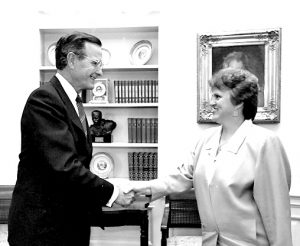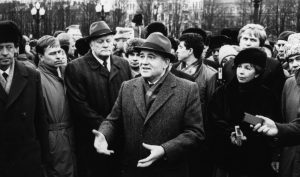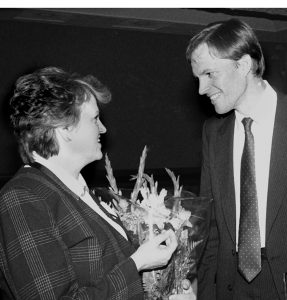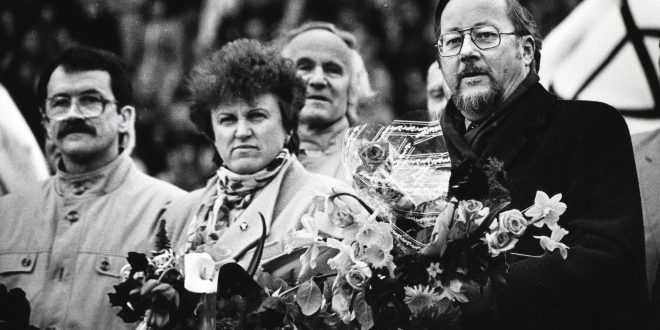Victor Nakas.
Walk to the White House
As we approached the northwest gate of the White House, we expected that our Lincoln sedan would just drive through. Instead, the guards told us to get out and walk through the pedestrian entrance. There they checked our IDs and riffled through the purse of the woman I was escorting. Satisfied, they told us to walk to the White House. As we proceeded up the driveway, unbeknownst to me, we were being observed by members of the press corps. Our stroll was to be featured on that evening’s national TV broadcasts. Once inside, Nicholas Burns, a State Department diplomat assigned to the National Security Council, provided us with visitor badges to hang around our necks. I put mine on. To her credit, my fellow visitor refused.
It was May 3, 1990. My companion was Kazimiera Prunskienė, the then Prime Minister of Lithuania. Two months earlier, Lithuania had declared its independence after decades of Soviet rule. She was there to meet President George H.W. Bush. I, an American-born son of Lithuanian refugees, came along for the ride (and the stroll) as her interpreter.
Independence Challenged
These two parties meeting in the Oval Office were each facing significant international pressure. Prunskienė and other Lithuanian leaders had been enduring heavy demands from the Kremlin.

On March 11, 1990, Lithuania’s parliament had voted to restore the independent state that existed between 1918 and 1940. Soviet leader Mikhail Gorbachev had allowed the Warsaw Pact to disintegrate in 1989, enabling its members to reclaim their sovereignty; however, he drew the line at altering the USSR’s territorial borders. Never mind that just before Christmas, the Soviet Union’s own Congress of People’s Deputies had condemned the secret protocols entered into by the USSR and Nazi Germany that consigned Estonia, Latvia, and Lithuania to the Soviet sphere of influence. These secret protocols set the stage for the absorption of the Baltic countries into the USSR. In January, Gorbachev traveled to Lithuania in a vain attempt to dissuade the Lithuanians from breaking free of Moscow’s grasp. His charm offensive, so pleasing to Western ears, came to naught in Vilnius. He found himself engaged in street-side arguments with local citizens.
Far from agreeing to negotiate the terms of Lithuania’s exit, Gorbachev had recently imposed an economic blockade on the nation that had accounted for less than 1.5 percent of the USSR’s population.
Prunskienė was at the White House now, ready to make a case for US support.
50 Years of Baltic Policy Recalled
President Bush agreed to the meeting because he was cornered by a longstanding U.S. policy he had no hand in formulating. Fifty years earlier, acting US Secretary of State Sumner Welles had issued a statement decrying the “devious processes whereunder the political independence and territorial integrity” of the Baltic republics were “deliberately annihilated.” He declared that “the people of the United States are opposed to predatory activities no matter whether they are carried on by the use of force or the threat of force.” Based on that July 1940 statement, the US had refused to recognize the incorporation of the Baltic States into the USSR. Throughout the ensuing decades, the US government – administration after administration – had demonstrated its fidelity to that principle by continuing to extend official accreditation to pre-World War II Baltic diplomats still posted in Washington. After the Welles declaration, year-in, year-out, Baltic Americans had pressed the White House, State Department, and their local members of Congress to pledge continued allegiance to the non-recognition policy.
A Presidential Demur

Growing up in Detroit, I recall the steady procession of Congressmen and Senators who appeared at our annual Lithuanian Independence Day commemorations. They invariably repeated the words we wanted to hear, unlikely though they were to bear fruit. Now, after decades of high-minded pronouncements by lawmakers, politicians, and State Department officials, Bush had before him the unenviable task of delivering the goods that he too had, at one time, endorsed before ascending to the Presidency. In March 1990, Lithuanian Americans waited expectantly for him to utter words to this effect: “Yes, the United States of America recognizes the newly independent Lithuanian state.” He demurred.
It proved to be a costly political decision for Bush. Some even believe it contributed to his unsuccessful bid for a second term. Invective poured down on him from Lithuanian Americans of all political stripes. They whipped up bipartisan support on Capitol Hill, calling in IOU’s collected over many years. Bush acknowledged their pressure at a press briefing the same day he met Prunskienė, telling reporters, “I must convince the Lithuanian Americans that my desire for their freedom…is just as strong as anyone else’s.” (He may have been the first and only US president to have declaimed to the White House press corps that he needed to convince Lithuanian Americans, who numbered under a million, of anything.)
Media Blitz

The tale of David doing battle with a Soviet Goliath, while at the same time another, larger and stronger US Goliath stood on the sidelines examining his fingernails, was widely covered by the media. Following the White House meeting, I listened in a hotel suite to our public relations honcho, a former press secretary for House Speaker Jim Wright, who was working for a firm engaged by Lithuanian-American businessman Juozas Kazickas to promote the Prunskienė visit. He supplied juicy details to The New York Times correspondent Maureen Dowd concerning the Prime Minister’s humiliating entree to the White House grounds. Dowd’s story landed on the paper’s front page. The better part of two days was devoted to a media charm blitz. Among other encounters, it included: an interview on the “Today” show, a luncheon address at the National Press Club; a visit to The Washington Post to meet with owner Katharine Graham and a conference room full of editors and reporters; a “Newsmaker” interview on PBS’s “McNeil-Lehrer Newshour,” and a buffet dinner at the home of media power couple Chris and Kathleen Matthews, where a dozen or more columnists and reporters seemed to hang on the Prime Minister’s every word. Prunskienė was so tightly scheduled that she had to be “on” even during her commutes around town. I recall a Wall Street Journal reporter jumping into Prunskienė’s car to interview her as we left a meeting with lawmakers on Capitol Hill.
More Kissingerian than Reaganesque
The upshot of the Bush-Prunskienė meeting was that both sides were left relatively satisfied. Bush found Prunskienė to be reasonable and disinclined to poke him in the eye over his political stance, which was more Kissingerian than Reaganesque. For her part, Prunskienė was happy the meeting occurred at all. In the brightest media spotlight imaginable, the President was respectfully addressing her as “Prime Minister” of a nation whose legitimacy the Soviets furiously disputed. Her winning personality and the driveway debacle served to elicit more public sympathy for the Lithuanian cause.
Bloody Sunday
On March 11, 1990, the mouse that was Lithuania had reared its little head and roared. Ten months later, its citizens faced the ultimate test. On January 13, 1991, Soviet special forces, backed by tanks, moved on the Lithuanian television tower in Vilnius. Ordinary unarmed citizens used their bodies as shields to defend their symbol of free speech and democracy. Fifteen protesters paid with their lives, some crushed under tank treads. The Black Berets won that battle, which played out in front of Western journalists, but the Soviet regime lost the war for hearts and minds in Washington, Moscow, and elsewhere. In the months before January 13, the wheeling-dealing Gorbachev had shifted his allegiance to Communist hardliners. After all these years, it’s still a mystery if he gave the direct order to seize the TV tower or if, channeling King Henry II, he asked his generals plaintively, “Will no one rid me of these troublesome Lithuanians?”

Not surprisingly, Gorbachev declines to this day to step foot on Lithuanian soil and explain himself to local prosecutors. Whether it was the generals or Gorbachev, someone in the Soviet leadership hesitated when the Lithuanians unexpectedly roared their loudest; the expected assault on the barricaded Lithuanian parliament building, where the country’s leaders were holed up, never materialized. Democratic Lithuania was wounded but resolute in its demand for independence.
Meanwhile, the leaders of the two superpowers remained wedded to old ways of thinking. Even after the massacre in Vilnius, Bush continued to stand by Gorbachev, while the Soviet strongman clung to his faith in Communism. For different reasons, both men shared the goal of preserving the USSR.
By the summer of 1991, Gorbachev had come to be reviled by both hardliners and reformers — by the former for letting Eastern Europe slip free and loosening the Communist Party’s iron grip on the populace it ruled, and by the latter, for the Vilnius killings and other betrayals of the reform movement.
Chicken Kiev

On August 1, Bush traveled to Ukraine where he warned the people there against suicidal nationalism. Later that month, The New York Times columnist William Safire derided the speech as “Chicken Kiev,” saying that Bush “lectured Ukrainians against self-determination, foolishly placing Washington on the side of Moscow centralism and against the tide of history.” Safire’s mocking reference wounded the President. The charge stuck further when soon after that events put the lie to the President’s misplaced warning. After all, it was not Baltic, Ukrainian or other nationalists who committed hara kiri, but rather Soviet Communists themselves. Four months after the President’s visit to Kiev, the Soviet Union was no more.
Dash to Freedom
In Leonard Wibberley’s satirical novel The Mouse That Roared, the tiny Grand Duchy of Fenwick declares war on the United States and, amazingly, wins. In real life, 35 years after the novel appeared, a nation the size of Ireland with no army to speak of, relying solely on the tools of democracy, declared and won independence from a behemoth brimming with troops and weapons. In commencing a war of wills with the Soviet Union, Lithuania set the superpower on a path to implosion that leaders in the White House neither envisioned nor desired. To be fair, Lithuania did not accomplish this feat on its own – Latvia and Estonia were one short step behind it in the dash to freedom. The other Baltic nations, Russians aligned with Boris Yeltsin, and popular front movements in Ukraine, Georgia, and elsewhere all contributed to the demise of the Soviet state.
History Bends to Vilnius
The narrative that began on March 11, 1990, is not one that disciples of American exceptionalism or balance of power enthusiasts are likely to be fond of recalling. To their way of thinking, history bends to the will mostly of Washington, and occasionally of Moscow or Beijing. The lesson from three decades ago is worth remembering. It tells us that sometimes history bends to the will of leaders and citizens in such places as Vilnius. Even without Lithuania, perhaps other forces could have precipitated the collapse of Soviet Communism. On the other hand, the Chinese Communist government’s brutal crackdown in Tiananmen Square in 1989 and the PRC’s resilience and flourishing as an Orwellian surveillance state that today poses the preeminent global threat to Western democracy suggest the USSR’s demise was not necessarily inevitable. Were it not for March 11, 1990, we could still be grappling with a Soviet menace far more dangerous than Putin’s Russia.
Even those Americans who might have thought otherwise 30 years ago should take a moment and give silent thanks to a mouse that roared and prevailed to the benefit of the entire world community.
Victor Nakas was the Washington manager of the Brooklyn-based Lithuanian Information Center from 1987 to 1991 and served as the political and press officer at the Embassy of Lithuania in Washington from 1991 to 1993.
 DRAUGAS NEWS Lithuanian World Wide News in English
DRAUGAS NEWS Lithuanian World Wide News in English
